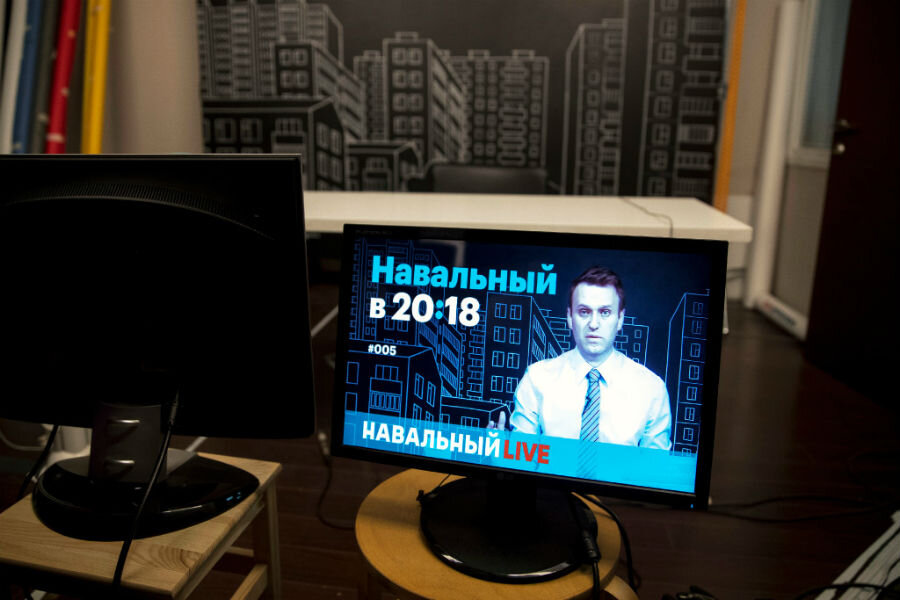Russian opposition leader finds new platform on YouTube
Loading...
After repeated jailings, court convictions on dubious charges and an attack that damaged his eye, Russian opposition leader Alexei Navalny is hard to unnerve. But every week his anxiety soars when he does a YouTube live broadcast.
“My heart beats so fast every time I do it, as if it’s going to jump out of my chest,” he said during the countdown for a recent episode.
The broadcasts have become a key piece of Mr. Navalny’s strategy to galvanize opposition to President Vladimir Putin and the upper echelons of power that he says are awash in corruption. The videos regularly attract more than a million views and contribute to the opposition’s resurgence after years of being marginalized and riddled by internal disputes.
Navalny’s YouTube channel added three new shows, including a program hosted by a former deputy energy minister, in recent weeks. Subscribers of Navalny. Live rose to 300,000 last week, just two months after it was launched.
His documentary about Prime Minister Dmitry Medvedev’s alleged ill-gotten wealth has been viewed more than 21 million times. This caught the Kremlin by surprise. A counterattack followed several weeks later including a much-promoted YouTube video comparing Navalny to Adolf Hitler and another by a pop-singer mocking opposition protesters.
Navalny has called for protests on June 12, a critical test for the campaign’s effectiveness. He hopes the response will repeat March demonstrations – triggered by the Medvedev documentary video – that rattled the Kremlin by their size and spread to 90 cities towns nationwide.
“It wasn’t that there were many people there – and there were – but the fact that there were many cities. With the video we managed to reach smaller towns,” he said.
Navalny made his name with a blog exposing official corruption in witty posts that resonated with Russia’s urbanites. Through his blog, he helped organize protests against electoral fraud in 2011 and the re-election of Vladimir Putin in 2012. Street protests were crushed after Mr. Putin’s return to the presidency.
Though blacklisted by state-controlled media, Navalny has broadened his reach substantially by tapping into the medium of choice for many young people to engage Russia’s once-apolitical youth.
“When we went online and I set up a blog, it wasn’t because I dreamt all my life of become a blogger or I love writing. We did it because there was no other way of communicating, no other possibility to tell people about our investigations,” Navalny told The Associated Press.
On his most recent broadcast he made fun of Alisher Usmanov, a multi-billionaire oligarch who dropped his usual reclusive ways to release a 12-minute insult video that ended with “I spit on you, Alexei Navalny.”
“The top story on all news today is the arrival of a new amazing video blogger – Alisher Burkhanovich Usmanov, one of Russia’s main oligarchs,” Navalny said at the opening of the show.
A week later, Usmanov released another angry video, signing off with “I spit on you again.”
Moscow-based political analyst Ekaterina Schulmann says the Kremlin’s reaction to Navalny’s popularity reflects the government’s aware that it needs “to fix something on television because people don’t watch us.”
The video portraying Navalny as a new Hitler got 2 million views and 14,000 likes, compared to 3.5 million views and 200,000 likes that Navalny’s video exposing Usmanov got two days earlier.
“I think our government has already lost the internet,” says Yegor Bestuzhev, an 18-year-old history major. “I think that going forward only Navalny will have this credibility on the internet.”
Ms. Schulmann says people who look for information online and attend rallies are not necessarily voters. “Can you convince people to go to the polls just as well as you can convince them to go to a rally? That is the question.”
Oksana Baulina, a veteran journalist who volunteered for Navalny’s campaign for Moscow mayor in 2013, directs the video campaign. A few months after she was recently hired, Ms. Baulina was jailed for seven days.
As Moscow riot police were snatching protesters at the unsanctioned rally on March 26, other officers stormed Navalny’s offices where Baulina and her associates were running a live stream from protests across the country. Nearly 140,000 were watching the live stream when police cut it off. Baulina and her colleagues spent up to 10 days in detention on charges of disobeying police orders to evacuate after to a bomb threat. Police confiscated all of the studio’s equipment as evidence, so Baulina’s team had to buy a new camera which cost about 70,000 rubles ($1,200) to record subsequent broadcasts.
Her small studio in Navalny’s office relies on cheap solutions such as roll-out photography backdrops and an inexpensive desktop computer.
“It’s about honesty and sincerity,” Baulina said. “I think people have really missed it – after so many years of pseudo-television that is actually the ministry of propaganda – this honesty and a chance of being heard.”
Navalny, who has faced prosecution on visibly trumped-up charges and had his blog on LiveJournal suspended, is realistic about what the Kremlin can do.
“I wouldn’t rule out that they will be talking about blocking YouTube if we keep growing,” Navalny says. “I think if they block YouTube, considering how many millions use it, everyone will just install VPN and use tools to get around the ban. That’s why the Kremlin right now focuses on fighting with us, creating their own content rather than on the outright ban.”
Sveta Kozlenko contributed to this report.







